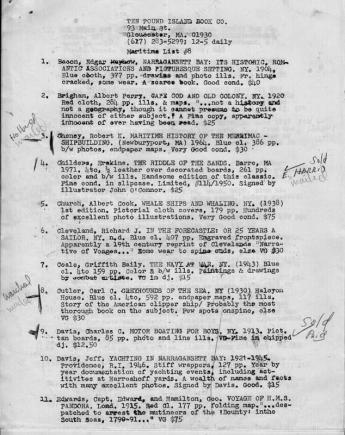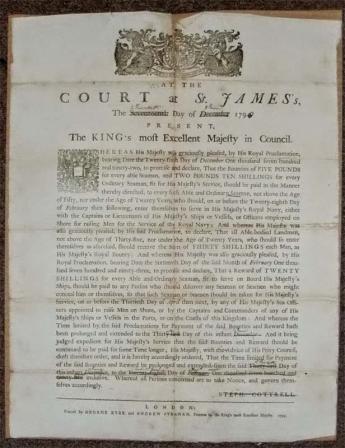Catalogue Reviews Antiquarian Booksellers' Association of America Ten Pound Island Book Company
Rare Book Catalogues - To E or Not to E

By Greg Gibson
A few years ago, in the course of one of my hyper-dramatized but mostly benign financial panics, I decided to stop issuing printed catalogs. Though I loved, and was proud of, my catalogs, they cost nearly of $4 each, and seemed to serve primarily as a vehicles for frustrated customers to complain about my grossly unfair manner of distributing them, or excuses for non-ordering pedants to inform me of the many grammatical and spelling errors they contained.
I sent hyper-dramatized farewells to customers who did not have email, and similarly dramatic announcement to the trade. Americana Exchange gave it some play, noting on their catalogs received page that Ten Pound Island was giving up the hard copy ghost, and that this was part of a “growing trend.”
Printed catalogs had been an integral part of my business since the early 1980s. I'd type up lists of thirty or forty items and take the typed sheets to my buddy who owned a fleet of industrial strength Xerox machines. Then another friend gave me a used AB Dick mimeo machine and I began messily self publishing my catalogs.
When I tired of ruining my clothes with mimeo ink, I found a printing shop to print folding Xerox-like catalogs. Then came the first catalog in TPI's classic 6x9 booklet format. It even had pictures, for which my local printer charged me an arm and a leg.
Then the Mac, and the excitement of WYSIWYG and postscript, and we were off to the races! Now I was in complete control of design, and had only to email a PDF to my print shop. While I was waiting to get my hard copies back, I'd do the list all over again in HTML and put it on my web page to coincide with the issue of the hard copy catalog. But of course it was precisely this technological advance that enabled me to quit issuing paper catalogs.
Well, the e-list plan lasted about six months. Then I started issuing printed catalogs again. I missed them too much. I missed creating them, and I missed the excitement when they came back from the printer, holding the first one out of the box as if it were a newborn babe. The first catalog in the new series was named, “I Know, I Know” as in, “I know I said I wouldn't issue any more of these but...”
So I was back in the game. But in one of my recent hyper-dramatized but mostly benign financial panics, I tweaked the formula yet again. Now I only issue hard copy catalogs every few months or so, with e-catalogs in between. And now the hard copy catalogs are slight affairs, with only a few items illustrated in color on glossy paper, with brief descriptions and instructions to check the website for more detailed descriptions and photos. That's where things stand at the moment, but we all know “the moment” lasts only a moment. Maybe next year's catalogs will be edible.
Two things worth noting before I shut up for another week.
E-Catalogs have a much shorter cycle than hard copy catalogs. With easy layout and zero publication time, e-material takes only a few days to move from concept to reality. Similarly, E-lists seem to have the shelf life of May flies. Maritime List 226, which was issued only as an e-list, sold just under 50% in two days and then stopped dead. Hard copy list 225, on the other hand, stretched out over two weeks. Apparently my customers have trained themselves to read e-lists immediately, order, and then discard. I'll bet other e-list people have experienced the same phenomenon.
And, I remember Maritime List 100, and what a special deal it was.
Who ever thought I'd get to 100? It had wraparound color covers, lots of illustrations, and some wonderful books. The thing was, many of the books it contained came from the library of a customer in Pennsylvania. He'd died and his widow was selling his books. The fellow had never bought much from me, so I was quite surprised when I entered his sumptuous library and saw one of my little booklets on a side table, on top of a stack of recent catalogs from some of the best dealers in England and America. My modest effort (although that issue had a particularly snazzy cover design) was probably the last catalog he'd read before he croaked, and the first one that came to the widow's eye. Consequently I got first crack at the library, and Maritime List 100 had material worth celebrating.
Since that happy accident I've come to consider the cost and time involved in issuing hard copy catalogs as an advertising expense, and a damned worthwhile one, at that. I may not bring any great books to the next book fair, but I'll have stacks of catalogs crammed with great books, and a sign that reads, “Catalogs are FREE. Help Yourself.”
Here's an item that is definitely NOT free, but still worth considering.
Broadside. At the Court at St. James's, The Seventeenth Day of December, 1794... Printed folio sheet, 15 x 19 1/2 inches, with manuscript additions. b/w engraved royal seal at top.
In 1794, with the outbreak of Britain's prolonged war with revolutionary France, the number of men required for the fleets rose to 85,000. By 1799 it was 120,000. The most common methods of increasing manpower were paying a bounty for service and pressing men into service. This rare broadside covers both approaches. Enlistments of experienced seamen were to be rewarded with bounties between five pounds and two pounds ten, depending on experience, and thirty shillings for landsmen between twenty and thirty-five years of age. Furthermore, a reward of twenty shillings was to be paid to "any person who should discover any Seaman or Seamen who might conceal him or themselves..." This policy led directly to the practice of seizing American sailors on the pretext that they were English and pressing them into duty in the Royal Navy. That policy, and America's angry reaction to it, was one of the causes of the War of 1812. This broadside has been updated in manuscript to June 20, 1799. The sheet is split along an old central fold at top, with no loss. $750
***
Posted on Bookman’s Log, presented here by permission of the author. Pictures: Bookman’s Log.
Do you want to learn more about booksellers’ catalogues?
>>> ILAB Catalogues of the Month
>>> Rare Booksellers’ First Catalogues, Part 1
>>> Rare Booksellers’ First Catalogues, Part 2
>>> Rare Booksellers’ First Catalogues, European Series




